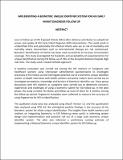Implementing a Biometric unique Identifier System for HIV Early Infant Diagnosis follow up

View/
Date
2016Author
Macharia, Mwangi Paul
Type
ArticleLanguage
enMetadata
Show full item recordAbstract
Loss to follow-up of HIV Exposed Infants (HEIs) after delivery contributes to suboptimal
access and uptake of HIV Early Infant Diagnosis (EID) interventions. This could result in
unidentified HEIs and potentially HIV-infected infants who are at risk of morbidity and
mortality where interventions such as Anti-retroviral therapy are not commenced.
Biometric identification of infants has been used successfully to increase immunization
coverage. This study investigated the feasibility and acceptability of using biometrics for
unique identification during EID follow-up of HEIs at the Kenyatta National Hospital High
risk Clinic. The study used a mixed methods approach.
A baseline evaluation was carried out among the HEI mothers or Caregivers and
healthcare workers using interviewer administered questionnaires to investigate
processes of HEI follow-up and interrogate potential use of a biometric unique identifier
system. In depth interviews with health workers and policy makers were carried out to
investigate perceptions, knowledge and barriers of biometric identifier use. Focus group
discussions with HEI mothers or caregivers were carried out to determine concerns,
experiences and challenges of using a biometric system for EID follow-up. In the pilot
phase, the study enrolled 78 infants and follow-up most of them for 4 months. During
the follow-up period, fingerprint templates were collected to measure the accuracy of
using fingerprints for HEI re-identification.
The qualitative study data was analyzed using AtlasTi Version 5.2 and the quantitative
data analyzed using SPSS 18. We anticipated positive findings in the accuracy of the
biometric system for infant unique identification. The insights from health workers and
mothers on integrating biometrics in EID follow-up were useful in informing system
design and implementation and potential roll out of a large scale biometric unique
identifier system. The pilot also informed a preliminary costing estimate of
implementing a National biometric unique identifier system for HEI follow-up.
Publisher
Africa Nazarene University
